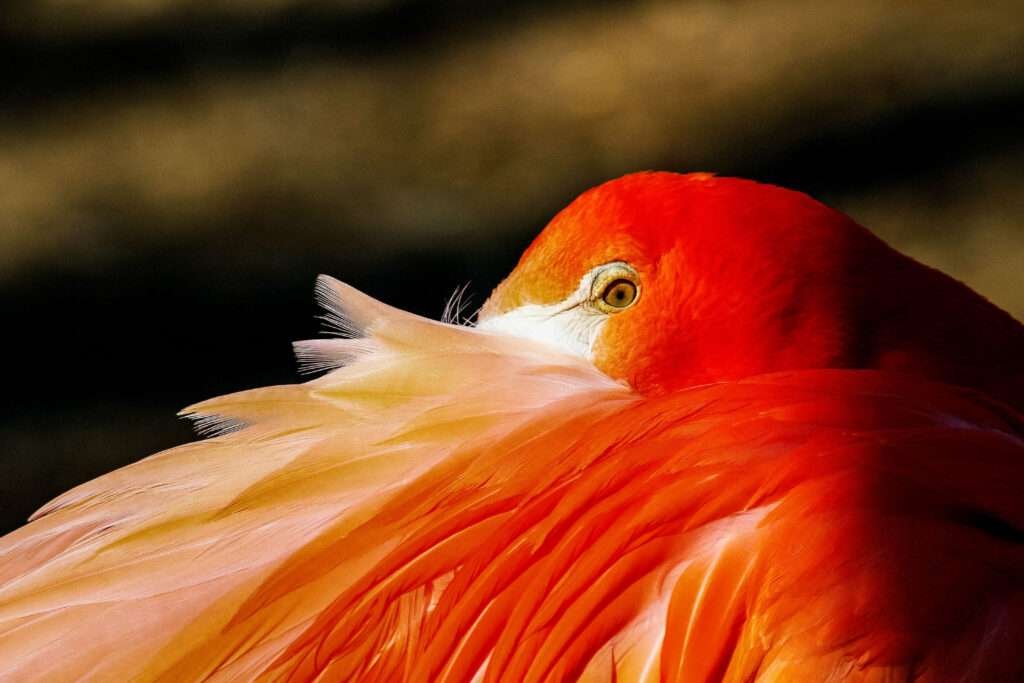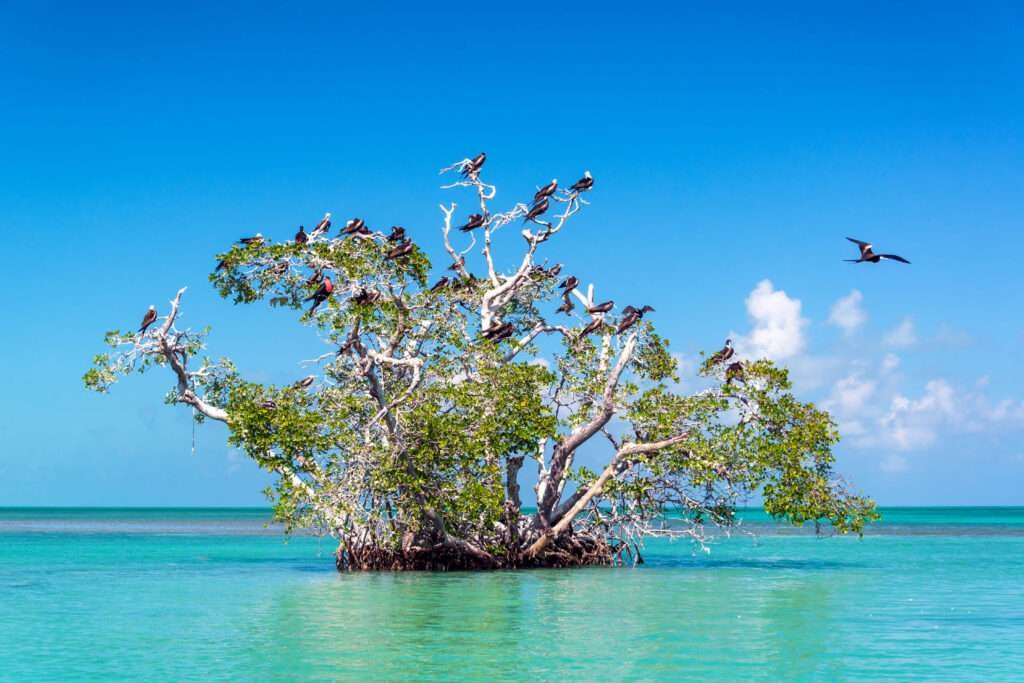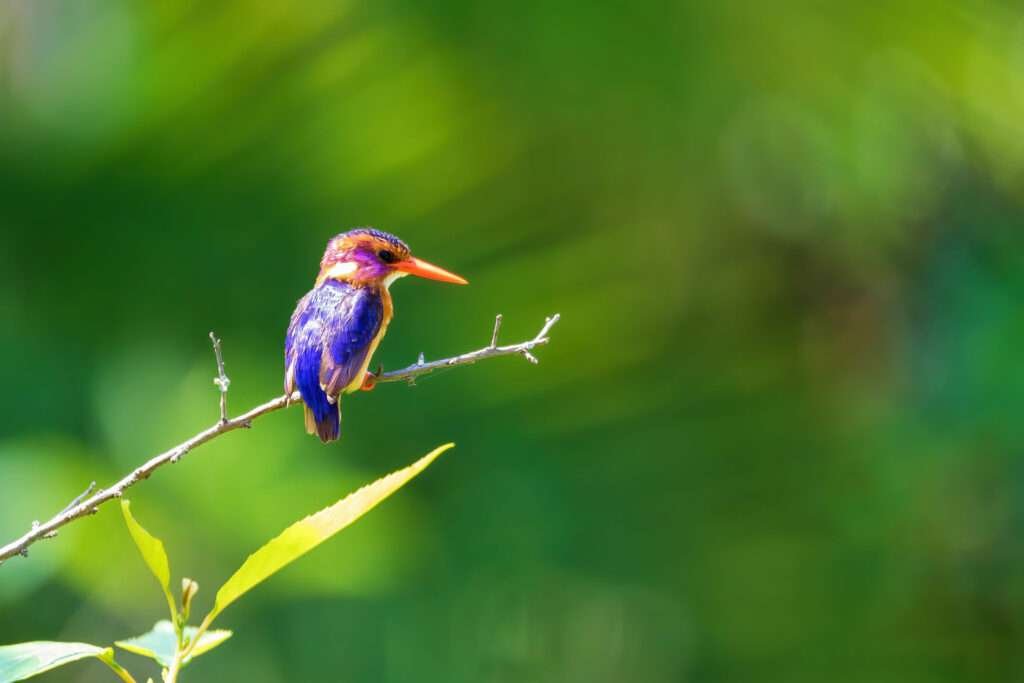Red bird species in Florida include the Northern Cardinal and Summer Tanager. These vibrant creatures are a common sight in Sunshine State gardens.
Florida is a thriving haven for birdwatchers and nature enthusiasts, with a diverse avian population that is easily observable throughout the state. Red birds, with their striking plumage, hold a special allure among the feathered gems. Whether perched at birdfeeders or flitting through canopies, these birds offer a glimpse of Florida’s rich biodiversity.
Keep your eyes peeled for the flash of red among the greens and blues of Florida’s landscapes—if you’re lucky, you may even spot the scarlet plumage of a red-headed woodpecker. As habitats vary from coastal mangroves to inland woodlands, each environment provides a unique backdrop for these captivating avian species.
Types of Red Birds
Florida’s skies are a canvas of colour, especially when it comes to red birds. Nature lovers and birdwatchers marvel at the variety of red-feathered friends gracing the Sunshine State. From the iconic Northern Cardinal to the vibrant Scarlet Tanager, each bird adds a splash of brilliance to the local fauna. Let’s soar into the world of these captivating creatures and discover the types of red birds that call Florida home.
Northern Cardinal
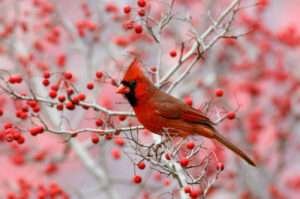
The Northern Cardinal is a year-round resident of Florida. Its bright red plumage and distinct crest make it one of the most recognisable birds.
- Male cardinals are entirely red, with a black face.
- Female cardinals have subtle hues, with touches of red on their wings and tails.
These birds prefer wooded areas, gardens, and shrublands. Often spotted at bird feeders, their vibrant colours brighten backyards.
Scarlet Tanager
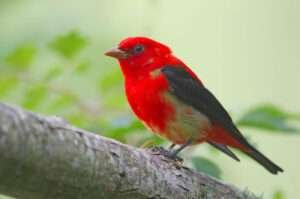
Scarlet Tanagers are a rare treat for Florida birders. These birds are known for their striking red bodies contrasted with black wings.
| Season | Habitat in Florida |
|---|---|
| Spring/Summer | Deciduous forests |
Catching sight of a Scarlet Tanager can be the highlight of any birdwatching excursion, as they tend to stay high in the treetops.
Painted Bunting
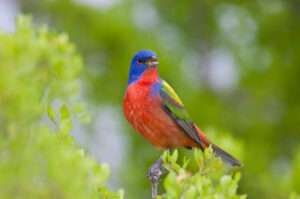
Due to its colourful plumage, people often refer to the Painted Bunting as a “flying rainbow”.
- The winter months are the best time to see these birds.
- They enjoy habitats such as brushy areas and thickets near water bodies.
Male-painted buntings showcase a mix of red, blue, and green, while females are a more subdued greenish-yellow.
Habitat and Distribution
The sunshine state of Florida is a symphony of colours, with red birds as its vibrant notes. Unique ecosystems, from dense forests and swamps to picturesque beaches and backyards, are home to these feathered beauties. Understanding where these red birds thrive helps birdwatchers and nature lovers pinpoint where they can witness these stunning creatures.
Native Red Birds
Native red birds of Florida exhibit various hues and inhabit various habitats. They often prefer areas rich in food sources and suitable nesting spots. Let’s delve into the homes of these majestic flyers.
- Northern Cardinals favour dense shrubbery and woodland edges.
- Red-headed woodpeckers are partial to open pine forests and swamps.
- Summer Tanagers enjoy mixed woodlands, often near streams.
Migratory red birds
Migratory red birds visit Florida, adding to the state’s biodiversity. During the winter, they travel thousands of miles from North to South America for warmer climates.
| Species | Winter Habitat |
|---|---|
| Scarlet Tanagers | Woodlands and groves |
| Painted Buntings | Brushy areas and thicketed borders |
Physical Characteristics
The red birds of Florida captivate with their vibrant plumage and spirited presence. Each species exhibits unique traits that make them a splendid sight. Let’s delve into the physical features that set these avian wonders apart. We’ll explore their feathers, beaks, and size to understand why birdwatchers treasure them.
Feathers
Red birds in Florida showcase a stunning spectrum of reds. For instance, a brilliant crimson cloaks the Northern Cardinal. Feather patterns vary widely, from the solid hues of the cardinal to the vivid streaks on a painted bunting. Florida’s red birds also exhibit seasonal changes in feathering, especially during mating periods, when colours intensify to attract mates.
Beak
The beaks of red birds serve as a tool kit. Every species tailors its beak to suit its specific diet and lifestyle. Cardinal beaks are stout, perfect for cracking seeds. By contrast, the Summer Tanager has a more streamlined beak suited for catching insects in flight. Beaks aren’t just for feeding; they also play a role in nesting and courtship activities.
Size
Size among Florida’s red birds varies significantly. To illustrate, cardinals typically measure 8–9 inches long, while the smaller Red-Winged Blackbird measures around 7 inches. The following table displays the size comparison:
| Bird Species | Length (inches) | Wingspan (inches) |
|---|---|---|
| Northern Cardinal | 8-9 | 10-12 |
| Summer Tanager | 6.5-7.5 | 11.5-12.5 |
| Red-Winged Blackbird | About 7 | 12-15.5 |
Sizes are approximate and can vary between males and females. Birdwatchers delight in observing these differences while in nature.
Behaviour and diet
Exploring the vibrant world of red birds in Florida brings us to the fascinating subjects of behaviour and diet. These feathered creatures display riveting social patterns and dietary habits that captivate bird enthusiasts and casual observers alike. Understanding their lifestyle offers a glimpse into the natural ballet of survival and reproduction that takes place in the Sunshine State’s ecosystems.
Courtship and mating
During courtship in Florida, red birds burst into a variety of behaviours. They showcase various courtship dances and aerial displays to woo potential mates. Male birds often exhibit vibrant feathers and melodious calls to attract females. These displays demonstrate vigour and the ability to be a good partner.
Nesting Habits
The nesting habits of Florida’s red birds are as varied as their species. Most prefer secluded areas, hidden from potential threats. They build nests using materials like twigs, grasses, and leaves. Safety for their chicks is paramount, so strategic location choices are made.
Feeding Preferences
Regarding sustenance, red birds in Florida have distinct feeding preferences. Their diet mainly consists of insects, seeds, and berries. Seasonal variations can alter their diet as well. Some species of red birds gather in groups to feed, turning eating into a social event.
Conservation Status
The conservation status of red birds in Florida is a vital concern for ecologists and bird enthusiasts alike. Across the state, many of these vibrant avians face challenges threatening survival. Recognising these hazards and supporting conservation efforts are key steps towards ensuring their future.
Threats
Several dangers loom over Florida’s red birds, jeopardising their existence. Predominant threats include:
- Habitat loss: Rapid urban development reduces vital nesting areas.
- Climate change: Erratic weather patterns disrupt food supplies and nesting sites.
- Pesticides: Chemicals used in agriculture harm birds directly and decrease insect populations, a primary food source.
- Non-native species: Invasive predators and competitors challenge native birds for resources.
Conservation Efforts
Thankfully, Florida is taking proactive steps to protect red birds.
- Legislation: Laws like the Endangered Species Act provide legal protection.
- Land protection: Building bird sanctuaries ensures safe habitats.
- Research: Ongoing studies help understand red birds’ needs better.
- Public education: awareness campaigns promote responsible behaviours.
Joint endeavours by government agencies, NGOs, and local communities propel these conservation strategies forward.
Interaction with Humans
Florida’s red birds, with their bright plumage, delight residents and visitors alike. People love observing, photographing, and inviting these feathered jewels into their spaces. This interaction brings joy and a sense of connection to nature. Creating a bird-friendly environment can lead to close-up encounters with these stunning creatures.
Attracting Red Birds to Your Yard
Inviting red birds to your yard is simple and rewarding. Start with the basics:
- Plant native shrubs and flowers that redbirds love.
- Install feeders with sunflower seeds, a favourite snack for many red birds.
- Add a water source, like a bird bath, for drinking and bathing.
- For shelter and nesting, maintain a natural habitat with trees and bushes.
To increase your chances of visits:
- Place feeders in quiet, sheltered areas.
- Use red accents on feeders or in your garden to catch their attention.
- Keep your yard safe from predators.
Birdwatching Tips
Birdwatching can be a fun and educational activity for all ages. Here are some tips to enhance your experience:
- Learn patterns: Be aware of when red birds are most active in your area.
- Educate yourself on the types of red birds that frequent Florida.
- Use a good pair of binoculars for clear, up-close views.
- Keep a bird-watching journal to record the species you spot.
Respect wildlife by observing from a distance and creating a peaceful environment for them to thrive.
Frequently Asked Questions
In Florida, what bird is red?
Florida is home to the Northern Cardinal, a common red bird.
What bird is red but not a cardinal?
A summer tanager is not a cardinal but rather a red bird. Scarlet Tanagers and Vermilion Flycatchers also feature vibrant red plumage.
What does a Florida Cardinal look like?
A Florida cardinal features vivid red plumage, a crest on its head, and a black face mask extending from beak to throat. The females are pale brown with hints of red on their wings and tail.
What do Florida redbirds eat?
Florida red birds primarily eat seeds, fruits, and insects, which provide the nutrition they need for their energetic lifestyles. Their diet may change with the seasons, favouring insects during the warmer months.
Conclusion
Exploring the vibrant red birds of Florida is a remarkable journey. These feathered gems offer a glimpse into the state’s rich biodiversity. As you venture outdoors, keep your eyes peeled for their stunning hues. Embrace the chance to spot these avian treasures.


